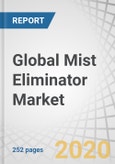The global mist eliminators market is projected to grow from USD 953 million in 2020 to USD 1,159 million by 2025, at a compound annual growth rate (CAGR) of 4% between 2020 and 2025.
“Wire-mesh mist eliminators is projected to witness the significant CAGR during the forecast period”
In terms of volume, the wire-mesh segment dominates the global mist eliminators market. Compared to the other types, wire-mesh mist eliminators offer cost advantage, high strength, low-pressure drop, and a moderate level of efficiency owing to which they are widely used in the oil & gas, chemical, and other industries. As application requirement changes to high-efficiency mist collection, the end-user has to shift toward vane type and fiber-bed mist eliminators.
“Distillation tower segment projected to lead the mist eliminators market from 2020 to 2025”
The distillation tower segment is estimated to grow at a significant CAGR during the forecast period. The growth can be attributed to the increasing demand from the petrochemical and oil & gas industries for new distillation tower installations and for retrofitting existing facilities to boost production and ensure regulatory compliance.
“The oil & gas segment projected to lead the mist eliminators market from 2020 to 2025”
The oil & gas segment is the largest and steady-growing end-use industry. This is mainly attributed to the stringent government regulations, strong emphasis on pure cut formation during refining, improved efficiency of the operation, and reduced load on regenerators, among others, which support the growth of the market. However, the declining oil prices, widening of the supply-demand gap, and COVID-19 pandemic effect had a severe impact on the mist eliminators market.
“APAC projected to account for the maximum share of the global mist eliminators market during the forecast period”
APAC is projected to lead the global mist eliminators market from 2020 to 2025. The market in the region is expected to witness a growing demand from the oil & gas and power generation industries due to increasing regulations and energy demand in the region. The growth of the APAC chemical sector is also creating opportunities for the mist eliminators market. The growing desalination industry is also driving the mist eliminators market in the region. In the power industry, due to stringent government regulations, mist eliminators are widely used for the reduction of SOx emission through flue gas desulfurization.
Research Coverage
The market study covers the mist eliminators market across various segments. It aims at estimating the market size and the growth potential of this market across different segments based on type, material, application, end-use industry, and region.
The study also includes an in-depth competitive analysis of key players in the market, along with their company profiles, key observations related to their products and business offerings, recent developments undertaken by them, and key growth strategies adopted by them to enhance their position in the mist eliminators market.
The global mist eliminators market comprises major manufacturers such as Sulzer Ltd. (Switzerland), CECO Environmental Corp. (US), Munters Group AB (Sweden), Koch-Glitsch LP (US), DuPont de Nemours, Inc. (US), Kimre Inc. (US), Hilliard Corporation (US), Monroe Environmental Corporation (US), and Begg Cousland Envirotec Limited (Scotland).
Breakup of Primaries
In-depth interviews were conducted with Chief Executive Officers (CEOs), marketing directors, innovation and technology directors, and other executives from various key organizations operating in the mist eliminators market.
- By Company Type: Tier 1: 40%, Tier 2: 20%, and Tier 3: 40%
- By Designation: C-level Executives: 20%, Directors: 20%, and Others: 60%
- By Region: North America: 40%, Europe: 15%, Asia-Pacific: 40%, and Rest of World: 5%
Key Benefits of Buying the Report
The report is expected to help the market leaders/new entrants in this market with information on the closest approximations of the revenue numbers of the overall mist eliminators market and its segments and sub-segments. This report is projected to help stakeholders understand the competitive landscape of the market and gain insights to improve the position of their businesses and plan suitable go-to-market strategies. The report also aims at helping stakeholders understand the pulse of the market and provides them with information on the key market drivers, challenges, and opportunities.
Table of Contents
Executive Summary
Companies Mentioned
- 3Nine AB
- Air Quality Engineering, Inc.
- Amacs
- Benvitec
- Ceco Environmental
- Coastal Technologies, Inc.
- Evergreen Technologies (P) Ltd.
- Finepac Structures Pvt. Ltd.
- FMC Technologies Inc.
- Hillard Corporation
- KCH Services Inc.
- Kimre, Inc.
- Koch-Glitsch
- Mecs, Inc.
- Munters AB
- RVT Process Equipment GmbH
- Sullair, LLC
- Sulzer Chemtech Inc.
- Varun Engineering Pvt. Ltd.
Methodology

LOADING...
Table Information
| Report Attribute | Details |
|---|---|
| No. of Pages | 252 |
| Published | October 2020 |
| Forecast Period | 2020 - 2025 |
| Estimated Market Value ( USD | $ 953 million |
| Forecasted Market Value ( USD | $ 1159 million |
| Compound Annual Growth Rate | 4.0% |
| Regions Covered | Global |
| No. of Companies Mentioned | 19 |









